
Mehmed III was the sultan of the Ottoman Empire from 1595 until his death in 1603. Mehmed was known for ordering the execution of his brothers and leading the army in the Long Turkish War, during which the Ottoman army was victorious at the decisive Battle of Keresztes. This victory was however undermined by some military losses such as in Győr and Nikopol. He also ordered the successful quelling of the Jelali rebellions. The sultan also communicated with the court of Elizabeth I on the grounds of stronger commercial relations and in the hopes of England to ally with the Ottomans against the Spanish.
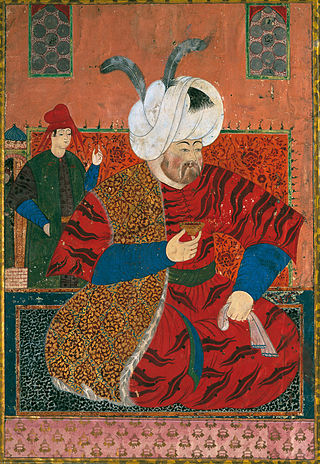
Selim II, also known as Selim the Blond or Selim the Drunkard, was the sultan of the Ottoman Empire from 1566 until his death in 1574. He was a son of Suleiman the Magnificent and his wife Hurrem Sultan. Selim had been an unlikely candidate for the throne until his brother Mehmed died of smallpox, his half-brother Mustafa was strangled to death by the order of his father and his brother Bayezid was killed on the order of his father after a rebellion against him and Selim.

Şehzade Mustafa was an Ottoman prince, son of sultan Suleiman the Magnificent and his concubine Mahidevran Hatun. He was the governor of Manisa from 1533 to 1541, of Amasya from 1541 to 1553, when he was executed by his father's order on charges of sedition and treason.
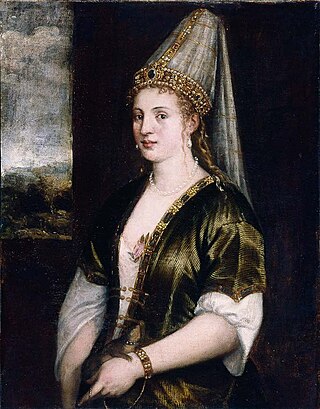
Hürrem Sultan, also known as Roxelana, was the chief consort and legal wife of the Ottoman Sultan Suleiman the Magnificent. She became one of the most powerful and influential women in Ottoman history, and as well a prominent figure during the period known as the Sultanate of Women.

Mimar Sinan also known as Koca Mi'mâr Sinân Âğâ, was the chief Ottoman architect, engineer and mathematician for sultans Suleiman the Magnificent, Selim II and Murad III. He was responsible for the construction of more than 300 major structures, including the Selimiye Mosque in Edirne, the Kanuni Sultan Suleiman Bridge in Büyükçekmece, and the Mehmed Paša Sokolović Bridge in Višegrad, as well as other more modest projects such as madrasa's, külliyes, and bridges. His apprentices would later design the Sultan Ahmed Mosque in Istanbul and the Stari Most bridge in Mostar.

Valide Sultan was the title held by the mother of a ruling sultan of the Ottoman Empire. The Ottomans first formally used the title in the 16th century as an epithet of Hafsa Sultan, mother of Sultan Suleyman I, superseding the previous epithets of Valide Hatun, mehd-i ulya. or "the nacre of the pearl of the sultanate".

The Laleli Mosque is an 18th-century Ottoman imperial mosque located in Laleli, Fatih, Istanbul, Turkey.

The Şehzade Mosque is a 16th-century Ottoman imperial mosque located in the district of Fatih, on the third hill of Istanbul, Turkey. It was commissioned by Suleiman the Magnificent as a memorial to his son Şehzade Mehmed who died in 1543. It is sometimes referred to as the "Prince's Mosque" in English. The mosque was one of the earliest and most important works of architect Mimar Sinan and is one of the signature works of Classical Ottoman architecture.

Sokollu Mehmed Pasha Mosque is a 16th-century Ottoman mosque in the Kadırga neighborhood in Fatih district, Istanbul, Turkey. It was commissioned jointly by the grand vizier Sokollu Mehmed Pasha and his wife İsmihan Sultan. It was designed by the imperial architect Mimar Sinan and completed in 1571/2. The mosque is noted for the fine quality of the Iznik tiles that decorate the interior walls.

Rüstem Pasha was an Ottoman statesman who served as Grand Vizier to Sultan Süleyman the Magnificent. Rüstem Pasha is also known as Damat Rüstem Pasha as a result of his marriage to the sultan's daughter, Mihrimah Sultan, in 1539. He is regarded as one of the most influential and successful grand viziers of the Ottoman Empire.
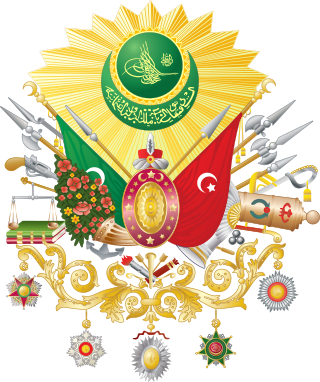
The following outline is provided as an overview of and topical guide to the Ottoman Empire:
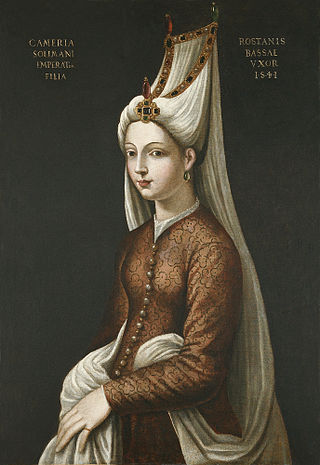
Mihrimah Sultan was an Ottoman princess, the daughter of Ottoman Sultan Süleyman the Magnificent and his wife, Hürrem Sultan. She was the most powerful imperial princess in Ottoman history according to historian Mustafa Selaniki who described her as the greatest and most respected princess and a prominent figure in the so-called Sultanate of Women. In Europe she was known as Sultana Cameria, while in Constantinople she was known as Büyük Sultan.

Şehzade Mehmed was an Ottoman prince, son of Sultan Suleiman the Magnificent and his wife Hürrem Sultan. He served as governor of Manisa.
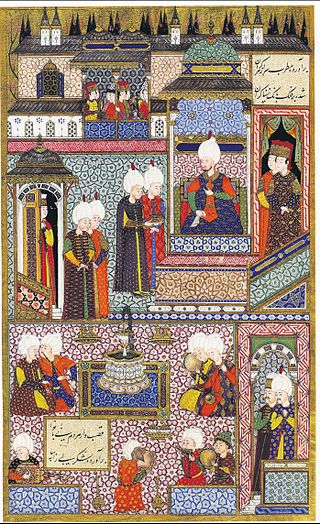
Şehzade Cihangir was an Ottoman prince, the sixth and youngest child of Sultan Suleiman the Magnificent and his wife Hürrem Sultan.
Gevherhan Sultan was an Ottoman princess, the daughter of Sultan Selim II and his favorite Nurbanu Sultan. She was the granddaughter of Suleiman the Magnificent and Hürrem Sultan, sister of Sultan Murad III and aunt of Sultan Mehmed III.
Hümaşah Sultan, also known as Hüma Sultan, was an Ottoman princess, the daughter of Şehzade Mehmed (1521–1543) and the granddaughter of Sultan Suleiman the Magnificent of the Ottoman Empire, and his favourite consort and legal wife Hurrem Sultan.
Ayşe Hümaşah Sultan was an Ottoman princess, the only daughter of Mihrimah Sultan and Rüstem Pasha. She was the granddaughter of Sultan Suleiman the Magnificent (1520–1566) and his legal wife Hürrem Sultan.

Classical Ottoman architecture is a period in Ottoman architecture generally including the 16th and 17th centuries. The period is most strongly associated with the works of Mimar Sinan, who was Chief Court Architect under three sultans between 1538 and 1588. The start of the period also coincided with the long reign of Suleiman the Magnificent, which is recognized as the apogee of Ottoman political and cultural development, with extensive patronage in art and architecture by the sultan, his family, and his high-ranking officials.
Semiz Ahmed Pasha was an Ottoman statesman who served as Grand Vizier of the Ottoman Empire from 13 October 1579 until his death on 27 April 1580.














